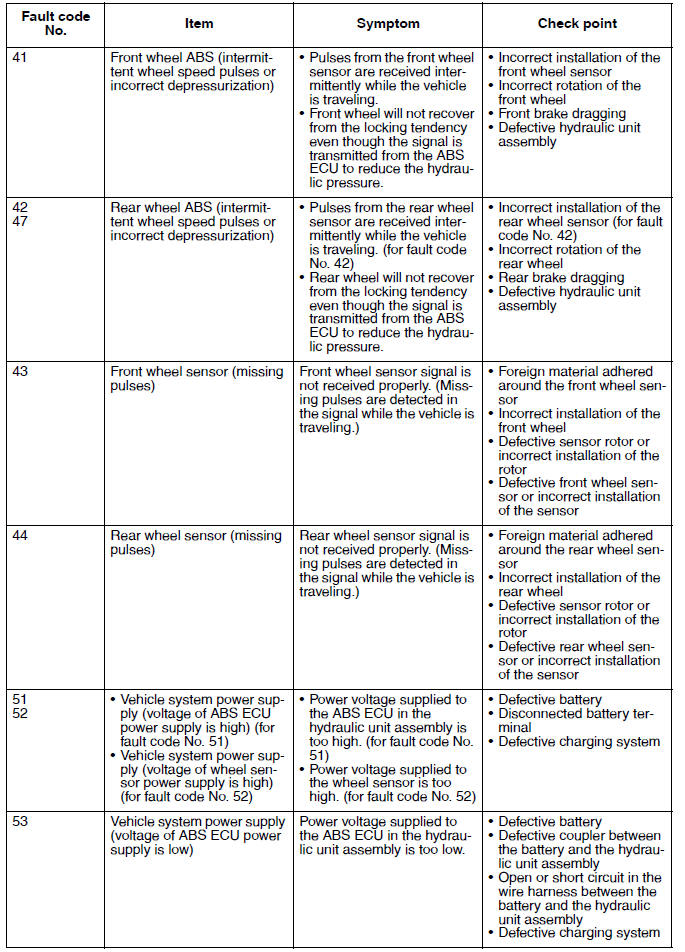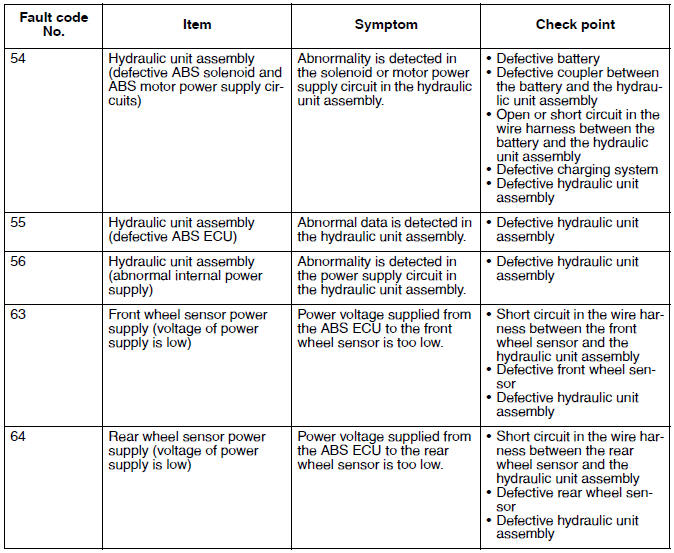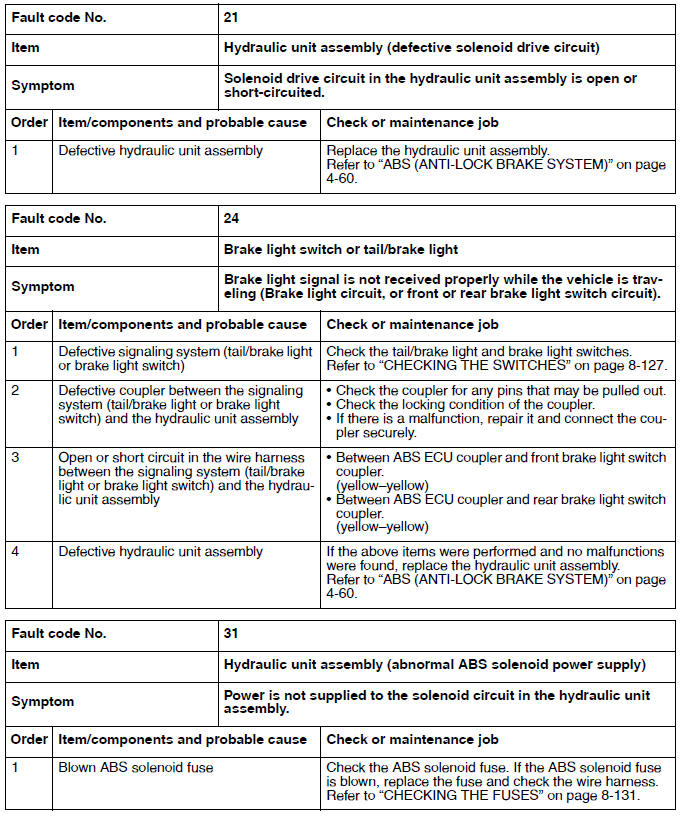 Yamaha Tracer MT09TRA - Service manual > ABS (ANTI -lock brake system)
Yamaha Tracer MT09TRA - Service manual > ABS (ANTI -lock brake system)
Circuit diagram

3. Main switch
4. Main fuse
5. ABS motor fuse
6. ABS solenoid fuse
11.Ignition fuse
12.ABS control unit fuse
13.Signaling system fuse
15.Battery
16.Engine ground
20.Joint connector
21.Joint coupler
22.Relay unit
23.Starting circuit cut-off relay
27.ECU (engine control unit)
45.Front wheel sensor
46.Rear wheel sensor
47.ABS ECU (electronic control unit)
51.Yamaha diagnostic tool coupler
52.Meter assembly
57.Multi-function meter
64.ABS warning light
69.Handlebar switch (right)
71.Start/engine stop switch
73.Front brake light switch
74.Rear brake light switch
ABS components chart

1. Hydraulic unit assembly
2. Fuse box 3
3. ABS test coupler
4. Rear wheel sensor
5. Rear wheel sensor rotor
6. Front wheel sensor
7. Front wheel sensor rotor
8. ABS warning light
9. Fuse box 2
ABS coupler location chart

1. Meter assembly coupler
2. Rear wheel sensor coupler
3. ABS ECU coupler
4. ABS test coupler
5. Front wheel sensor coupler
Maintenance of the abs ecu troubleshooting
Checking the ABS ECU
1. Check:
- Terminals "1" of the ABS ECU
Cracks/damages → Replace the hydraulic unit assembly, brake hoses, and brake pipes that are connected to the assembly as a set.
- Terminals "2" of the ABS ECU coupler
Connection defective, contaminated, come-off → Correct or clean.
TIP
If the ABS ECU coupler is clogged with mud or dirt, clean with compressed air.

ABS TROUBLESHOOTING OUTLINE
8-97 EAS30845 MAINTENANCE OF THE ABS ECU Checking the ABS ECU 1. Check: - Terminals "1" of the ABS ECU Cracks/damages → Replace the hydraulic unit assembly, brake hoses, and brake pipes that are connected to the assembly as a set.
- Terminals "2" of the ABS ECU coupler Connection defective, contaminated, come-off → Correct or clean.
TIP If the ABS ECU coupler is clogged with mud or dirt, clean with compressed air.
EAS30528 ABS TROUBLESHOOTING OUTLINE This section describes the troubleshooting for the ABS in detail. Read this service manual carefully and make sure you fully understand the information provided before repairing any malfunctions or performing service.
The ABS ECU (electronic control unit) has a self-diagnosis function. When failures occur in the system, the ABS warning light on the meter assembly indicates a malfunction.
The following troubleshooting describes the problem identification and service method using the Yamaha diagnostic tool. For information about using the Yamaha diagnostic tool, refer to "[B-2] DIAGNOSIS USING THE FAULT CODES" . For troubleshooting items other than the following items, follow the normal service method.
WARNING EWA16710 When maintenance or checks have been performed on components related to the ABS, be sure to perform a final check
WARNING
When maintenance or checks have been performed on components related to the ABS, be sure to perform a final check before delivering the vehicle to the customer.
ABS operation when the ABS warning light comes on
1. The ABS warning light remains on → ABS operates as a normal brake system.
- A malfunction was detected using the ABS self-diagnosis function.
- The ABS self-diagnosis has not been completed.
The ABS self-diagnosis starts when the main switch is turned to "ON" and finishes when the vehicle has traveled at a speed of approximately 10 km/h (6 mi/h).
2. The ABS warning light comes on after the engine starts, and then goes off when the vehicle starts moving (traveling at a speed of approximately 10 km/h (6 mi/h)). → ABS operation is normal.
3. The ABS warning light flashes → ABS operation is normal.
Self-diagnosis and servicing
The ABS ECU has a self-diagnosis function. By utilizing this function, quick problem identification and service are possible. Previous malfunctions can be checked since the ABS ECU also stores the malfunction history.
The fault codes recorded in the ABS ECU can be checked using the Yamaha diagnostic tool. When the service is finished, check the normal operation of the vehicle, and then delete the fault code(s). For information about deleting the fault codes, refer to "[B-3] DELETING THE FAULT CODES". By deleting the fault codes stored in the ABS ECU memory, it is possible to pursue the cause correctly if another malfunction occurs.
TIP
The ABS performs a self-diagnosis test for a few seconds each time the vehicle first starts off after the main switch was turned to "ON". During this test, a "clicking" noise can be heard from under the seat, and if the brake lever or brake pedal are even slightly applied, a vibration can be felt at the lever and pedal, but these do not indicate a malfunction.
Self-diagnosis using the ABS ECU
The ABS ECU performs a static check of the entire system when the main switch is turned to "ON". It also checks for malfunctions while the vehicle is ridden. Since all malfunctions are recorded after they are detected, it is possible to check the recorded malfunction data by utilizing the Yamaha diagnostic tool when the ABS ECU has entered the self-diagnosis mode.
Special precautions for handling and servicing a vehicle equipped with ABS
NOTICE
Care should be taken not to damage components by subjecting them to shocks or pulling on them with too much force since the ABS components are precisely adjusted.
- The ABS ECU and hydraulic unit are united assemblies and cannot be disassembled.
- The malfunction history is stored in the memory of the ABS ECU. Delete the fault codes when the service is finished. (This is because the past fault codes will be displayed again if another malfunction occurs.)
Basic process for troubleshooting
- WARNING
- Perform the troubleshooting [A]→[B]→[C] in order. Be sure to follow the order since a wrong diagnosis could result if the steps are followed in a different order or omitted.
- Use sufficiently charged regular batteries only.
[A] Malfunction check using the ABS warning light
[B] Use the Yamaha diagnostic tool and determine the location of the malfunction and the cause from the recorded fault code.
Determine the cause of the malfunction from the condition and place where the malfunction occurred.
[C] Servicing the ABS
Execute the final check after disassembly and assembly.

WARNING
When maintenance or checks have been performed on components related to the ABS, be sure to perform a final check before delivering the vehicle to the customer.
[A] checking the abs warning light
Turn the main switch to "ON". (Do not start the engine.)
1. The ABS warning light does not come on.
- Only the ABS warning light fails to come on. [A-1]
- The ABS warning light and all other indicator lights fail to come on. [A-2]
2. The ABS warning light comes on. [A-3]
[A-1] only the abs warning light fails to come on
1. Check for a short circuit to the ground between the green/red terminal of the ABS ECU coupler and green/red terminal of the meter assembly.
- If there is short circuit to the ground, the wire harness is defective. Replace the wire harness.
2. Disconnect the ABS ECU coupler and check that the ABS warning light comes on when the main switch is turned to "ON".
- If the ABS warning light does not come on, the meter assembly circuit (including the ABS warning light [LED]) is defective. Replace the meter assembly.
- If the ABS warning light comes on, the ABS ECU is defective. Replace the hydraulic unit assembly.
[A-2] the abs warning light and other indicator
1. Main switch
- Check the main switch for continuity.
- If there is no continuity, replace the main switch/immobilizer unit.
2. Battery
- Check the condition of the battery.
- If the battery is defective, clean the battery terminals and recharge it, or replace the battery.
3. Main fuse
- Check the fuse for continuity.
- If the main fuse is blown, replace the fuse.
4. Circuit
- Check the meter assembly circuit.
- If the meter assembly circuit is open, replace the wire harness.
[A-3] the abs warning light comes on
Connect the Yamaha diagnostic tool to the ABS test coupler and execute functional diagnosis. (For information about how to execute functional diagnosis, refer to the operation manual that is included with the tool.) Check that communication with the ABS ECU is possible.
- Only the ABS ECU fails to communicate. [A-4]
- ABS ECU and FI ECU fail to communicate. [A-5]
- Communication is possible with the ABS ECU. [B-1] (The ABS is displayed on the select unit screen.)
[A-4] only the abs ecu fails to communicate
1. ABS ECU fuse
- Check the ABS ECU fuse for continuity
- If the ABS ECU fuse is blown, replace the fuse.
2. ABS ECU coupler
- Check that the ABS ECU coupler is connected properly. For information about connecting the ABS ECU coupler properly, refer to "INSTALLING THE HYDRAULIC UNIT ASSEMBLY"
3. Wire harness
- Open circuit between the main switch and the ABS ECU, or between the ABS
ECU and the ground.
Check for continuity between brown/blue terminal of the main switch coupler and brown/red terminal of the ABS ECU coupler.
Check for continuity between black/yellow terminal of the ABS ECU coupler and the ground.
If there is no continuity, the wire harness is defective. Replace the wire harness.
- Open circuit in the wire harness between the ABS ECU coupler and the ABS
test coupler.
Check for continuity between light green/blue terminal of the ABS ECU coupler and light green/blue terminal of the ABS test coupler. (CANH) Check for continuity between light green/white terminal of the ABS ECU coupler and light green/white terminal of the ABS test coupler. (CANL)
4. ABS ECU malfunction
Replace the hydraulic unit assembly.
[A-5] abs ecu and fi ecu fail to communicate
1. Yamaha diagnostic tool
Check that the Yamaha diagnostic tool is properly connected.
2. Wire harness
- Open circuit in the wire harness between the ABS ECU coupler and the ABS
test coupler.
Check for continuity between light green/blue terminal of the ABS ECU coupler and light green/blue terminal of the ABS test coupler. (CANH) Check for continuity between light green/white terminal of the ABS ECU coupler and light green/white terminal of the ABS test coupler. (CANL)
[B-1] malfunction are currently detected
When the Yamaha diagnostic tool is connected to the ABS test coupler, the fault codes will be displayed on the computer screen.
- A fault code is displayed. [B-2]
- A fault code is not displayed. [C-1]
[B-2] diagnosis using the fault codes
This model uses the Yamaha diagnostic tool to identify malfunctions.
For information about using the Yamaha diagnostic tool, refer to the operation manual that is included with the tool.
 Yamaha diagnostic tool 90890-03231
Yamaha diagnostic tool 90890-03231
Connecting the Yamaha diagnostic tool
Removing the rider seat. Refer to "GENERAL CHASSIS (1)"
Removing the protective cap "1", and then connect the Yamaha diagnostic tool to the coupler.

Details about the displayed fault codes are shown in the following chart. Refer to this chart and check the vehicle.
Once all the work is complete, delete the fault codes. [B-3]
TIP
- When the Yamaha diagnostic tool is connected to the vehicle, the operation of the multi-function meter and indicators will be different from the normal operation.
- Check the inspection points after terminating the connection with the Yamaha diagnostic tool and turning the main switch off.
Operation of the Yamaha diagnostic tool (Fault diagnosis mode)
Malfunction results are displayed in the top part of the window area.

1. Recovered
The item list of the malfunction detected in the past (already recovered) are displayed.
2. Detected
The item list of the malfunction currently occurred are displayed.
3. Code

A. Detected malfunction
B. Recovered malfunction
4. ECU
The types of the control units are displayed.
(e.g., FI, ABS)
5. Item
The item names of the detected malfunction are displayed.
6. Condition
The current conditions are displayed. (Detected/Recovered)
7. Symptom
The symptoms of the detected malfunction are displayed.
8. Diagnosis code
The diagnosis codes related to the detected malfunction are displayed.
Fault code table
TIP
Record all of the fault codes displayed and inspect the check points.





*The fault code number varies according to the vehicle conditions. For details, refer to the "Troubleshooting details".
Troubleshooting details


TIP
With the front wheel stopped, the rear wheel was rotated for longer than about 20 seconds (fault code No. 11) or for longer than about 2 seconds (fault code No. 25).


TIP
- If the front brake ABS operates continuously for 20 seconds or more,
fault code No. 26 will be recorded.
If the front brake ABS operates continuously for 36 seconds or more, fault code No. 13 will be recorded.
- Vehicle possibly ridden on uneven roads.

TIP
- If the rear brake ABS operates continuously for 20 seconds or more,
fault code No. 27 will be recorded.
If the rear brake ABS operates continuously for 36 seconds or more, fault code No. 14 will be recorded.
- Vehicle possibly ridden on uneven roads.



TIP
If pulse gaps are detected when the vehicle is traveling at a speed of 30 km/h (19 mi/h) or more, fault code No. 17 will be recorded. If the vehicle is traveling at a speed of 29 km/h (18 mi/h) or less, fault code No. 45 will be recorded first and fault code No. 17 will be recorded if the condition continues.

TIP
If pulse gaps are detected when the vehicle is traveling at a speed of 30 km/h (19 mi/h) or more, fault code No. 18 will be recorded. If the vehicle is traveling at a speed of 29 km/h (18 mi/h) or less, fault code No. 46 will be recorded first and fault code No. 18 will be recorded if the condition continues.









[B-3] deleting the fault codes
To delete the fault codes, use the Yamaha diagnostic tool. For information about deleting the fault codes, refer to the operation manual of the Yamaha diagnostic tool.
Check that all the displayed fault codes are deleted.
 Yamaha diagnostic tool 90890-03231
Yamaha diagnostic tool 90890-03231
Connecting the Yamaha diagnostic tool
Remove the protective cap "1", and then connect the Yamaha diagnostic tool to the coupler.

[C-1] final check
Check all the following items to complete the inspection.
If the process is not completed properly, start again from the beginning.
Checking procedures
1. Check the brake fluid level in the brake master cylinder reservoir and brake fluid reservoir.
Refer to "CHECKING THE BRAKE FLUID LEVEL"
2. Check the wheel sensors for proper installation.
3. Perform brake line routing confirmation.
Refer to "HYDRAULIC UNIT OPERATION TESTS"
If it does not have reaction-force properly, the brake hose is not properly routed or connected.
4. Delete the fault codes.
Refer to "[B-3] DELETING THE FAULT CODES"
5. Checking the ABS warning light.
Refer to "CHECKING THE ABS WARNING LIGHT"
If the ABS warning light does not turn off, the possible causes are following:
- The problem is not solved.
- Open circuit between the ABS ECU and the meter assembly.
Check for continuity between green/red terminal of the ABS ECU coupler and green/red terminal of the meter assembly coupler.
- Malfunction in the meter assembly circuit.
- Malfunction in the ABS warning light circuit in the hydraulic unit assembly.
See also:
 Yamaha Tracer MT09TRA - Service manual > Fuel pump system
Yamaha Tracer MT09TRA - Service manual > Fuel pump system
Circuit diagram 3. Main switch 4. Main fuse 11.Ignition fuse
 Yamaha Tracer MT09TRA - Service manual > Electrical components
Yamaha Tracer MT09TRA - Service manual > Electrical components
1. Main switch/Immobilizer unit 2. Clutch switch 3. Front brake light switch

 BMW G310GS
BMW G310GS Honda CBR125RW
Honda CBR125RW Husqvarna 401 Vitpilen
Husqvarna 401 Vitpilen KTM 890 Duke R
KTM 890 Duke R Mash Dirt Track 650
Mash Dirt Track 650 Peugeot Kisbee
Peugeot Kisbee Yamaha Tracer MT-09
Yamaha Tracer MT-09 Honda CBR125RW
Honda CBR125RW Peugeot Kisbee
Peugeot Kisbee Yamaha Tracer MT-09
Yamaha Tracer MT-09